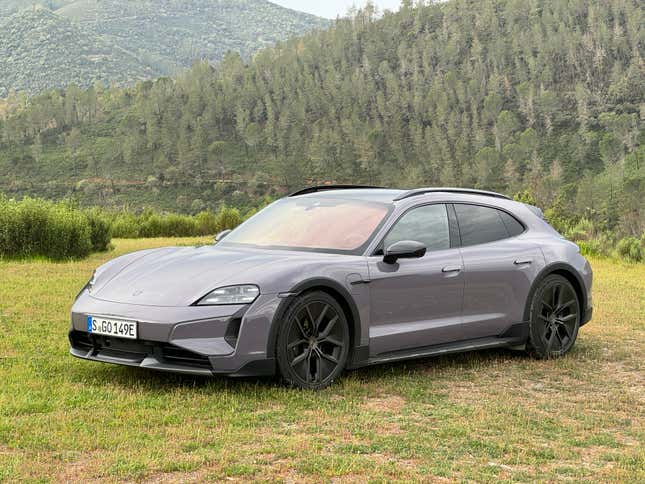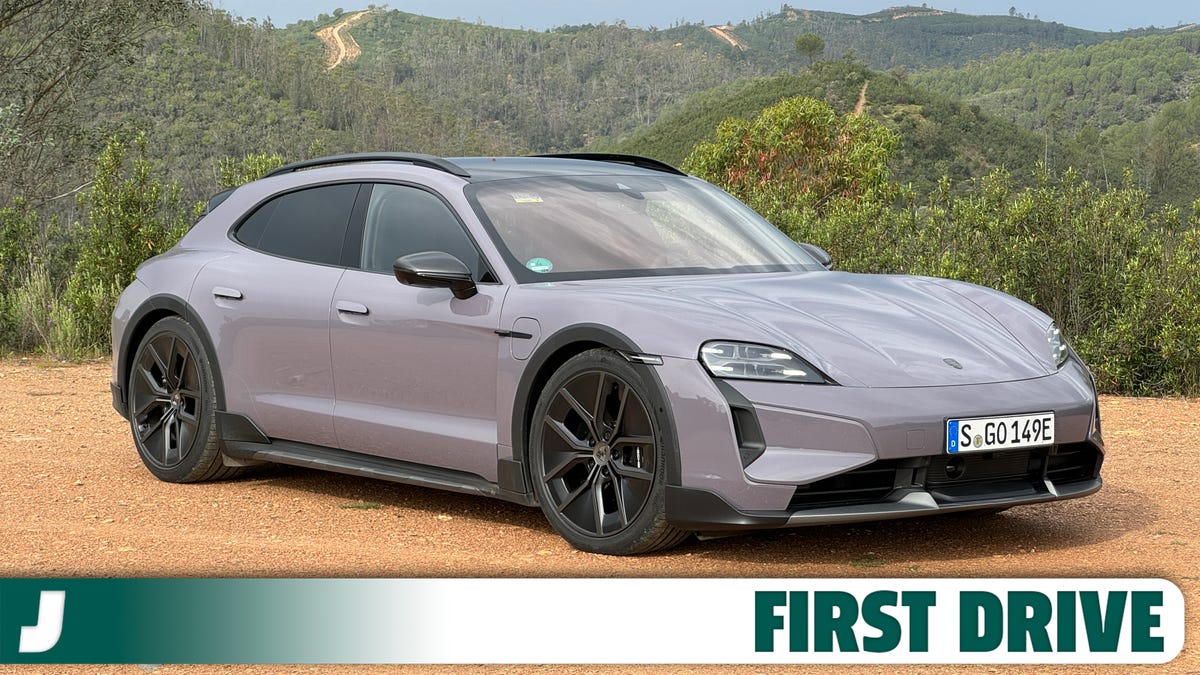Just before dinner on the first night of the 2025 Porsche Taycan drive program, model line spokesperson Mayk Wienkötter broke down what percentage of the facelift’s development cost went to improving what part of the car: 29 percent for efficiency, 25 percent for performance, 16 percent for charging, 16 percent for design, 11 percent for infotainment and 3 percent for comfort. While it did make me chuckle at first, the very Germanic pie chart used in the presentation is the ideal way to describe the facelifted Taycan.
Although it’s not massively improved in any single area, the updated Taycan fixes the old model’s biggest flaws while bettering all of the things that were already excellent. It’s quicker both to accelerate and to charge, has more power and a longer range, and offers a variety of new performance and tech features. It’s the kind of comprehensive engineering update we’ve come to expect from Porsche, and one that’s especially welcome on what I think is the brand’s best offering, GT stuff aside.
Full disclosure: Porsche flew me out to Seville, Spain so I could experience the entire 2025 Taycan lineup, including the Turbo GT that will have a separate review. I was put up in a very nice hotel, ate some very good cheese and drove on some very good roads. I also woke up late on the morning of the drive and Porsche didn’t leave without me, which I am very thankful for.
Our drive route to Circuito Monteblanco takes about two and a half hours, consisting of a few extended highway stretches but mostly some of the best two-lane (barely, in some parts) roads I’ve ever driven. Porsche has nearly every possible configuration available for us to drive, all the way from a base rear-drive sedan to a fully loaded Turbo S Cross Turismo. I, of course, decide to take one of the latter, specifically choosing a Turbo S wagon in the gorgeous new Provence color — the only wagon there in the lavender hue. (I really needed to have the purple wagon; I replied to Porsche’s email and called dibs on it within 30 seconds.)
Every version of the Taycan has a new rear-axle motor that’s up 107 horsepower over the outgoing model, so even the base rear-wheel-drive model packs 482 hp and can go from 0 to 60 mph in 4.5 seconds. Out of all the Taycans, the Turbo S gets the biggest boost in power. Its dual-motor configuration now puts out a maximum of 938 horsepower and 818 pound-feet of torque, making it comfortably Porsche’s most powerful production car of all time.
There are quicker EVs out there, and I’ve driven them, but the Turbo S is still quick enough to literally take my breath away. Using Porsche’s super easy launch control the Turbo S Cross Turismo will hit 60 mph in 2.4 seconds, with the sedan being a tenth quicker — those figures are each 0.3 second quicker than last year’s models. Past 60 mph the car pulls harder than the old one too, and the Sport Chrono package’s push-to-pass function can now provide a greater boost of 94 hp for up to 10 seconds. It’s like taking a shot of adrenaline.
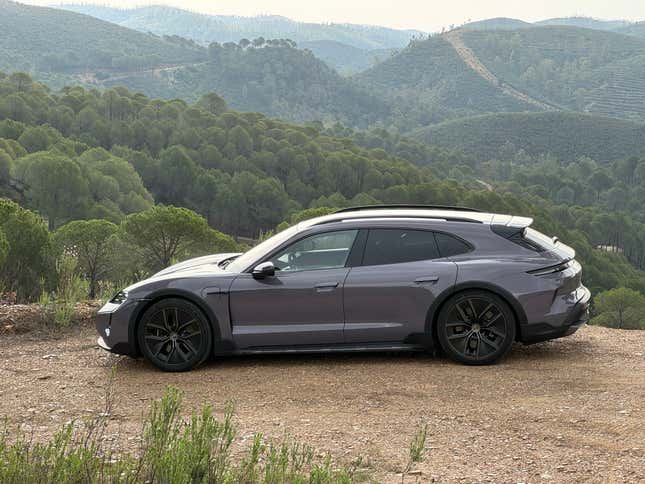
The two-speed transmission’s shifts seem to pack a stronger punch than before, and the sensation of shifting in an EV continues to be an entertaining one. Porsche is still against one-pedal driving, which I still find annoying, but the new Taycan’s 400 kW of energy recuperation power under braking is up more than 30 percent. The brake pedal feel is excellent, and the extra regen power is definitely noticeable. Porsche’s carbon-ceramic brakes remain some of the best in the biz, without any of the jerkiness or squealing that normally comes with carbon stoppers, and the physical braking blends nicely with the recuperation.
It’s the updated Taycan’s handling that makes the most lasting impression. Like before it has some of the best steering you can buy today, with lots of feedback, a quick rack and great weighting; the available 2.8-degree rear-axle steering further improves responsiveness and cuts down the turning radius by nearly two feet. Porsche’s Torque Vectoring Plus system adds an electronically controlled rear diff for increased agility and traction. Adaptive air suspension is now standard across the board, but the big news is the availability of Porsche’s Active Ride suspension system.
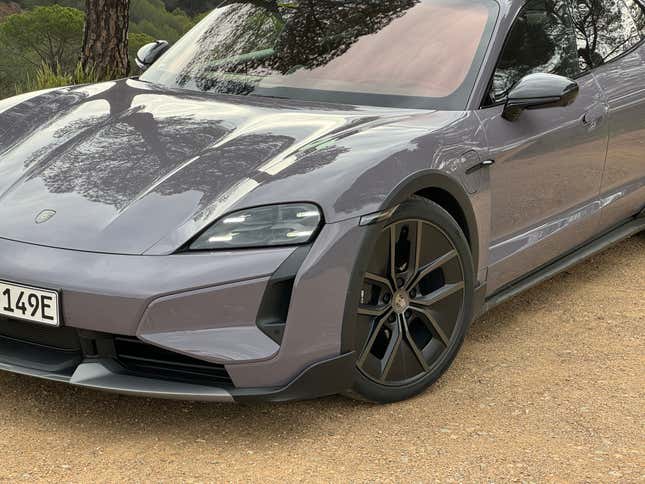
Along with two-chamber air springs, Active Ride incorporates an electrically driven hydraulic motor pump unit with each active two-valve damper; they act as an anti-roll bar, which means actual anti-roll bars aren’t needed. It can instantly change the flow inside each individual damper on the fly to control compression, rebound and ride height, with the aim to keep the car’s ride as smooth and level as possible. Even with 21-inch wheels the Turbo S’ ride is sublime over cobblestones and rough pavement, and it handles dips and off-camber situations really well.
In the Normal drive mode, you can toggle on Active Tilt Control and Active Pitch Control, features exclusive to cars with Active Ride. Tilt Control makes the Taycan lean into corners like a motorcycle while Pitch Control keeps the Taycan level under hard acceleration and braking, and both are really noticeable and, in my opinion, really nice. Driving at a normal pace on a windy road can get tiring, but these two settings make it a more pleasant experience. Jumping in the car for the first time with both activated, you’d be forgiven for thinking the car just always behaves like that, as the curve and pitch corrections feel organic. In Sport and Sport Plus modes these features are disabled, as Porsche says it’s better for the car to behave naturally when doing performance driving — a fair reasoning, though I wish I could still turn them on.
The funniest (and yet most useful) benefit of Active Ride is the “easy entry” function. When toggled on, the Taycan’s suspension will automatically raise by 2.2 inches as soon as one of the doors is opened, whether that be from inside the car or outside of it. It really does make the car easier to get in and out of, and its super fast operation and funny hydraulic whizzing noises make me laugh every time. Active Ride is standard on Turbo models but a $7,140 option on the 4S, and it’s not available for the rear-drive models.
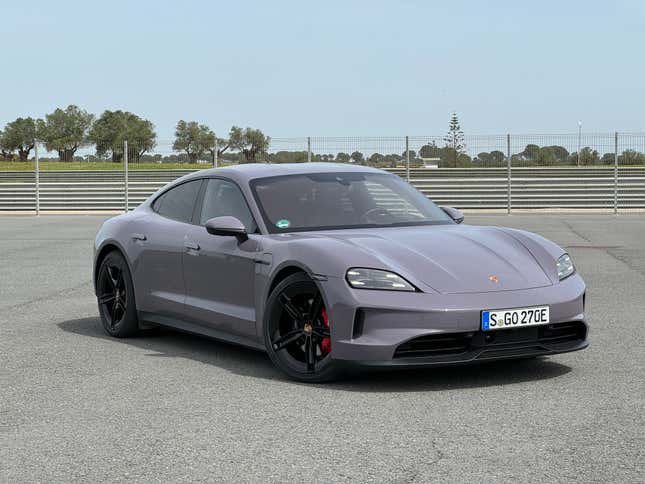
Later in the day, between stints of track time in the Taycan Turbo GT (the embargo of which drops next week), I get a chance to drive a Taycan 4S sedan, also in Provence and loaded with all of the same performance options. With a 0-60 time of just 3.5 seconds it’s mega quick, and it has all of the handling goodness of the Turbo models. This sedan does feel a bit more nimble, being about 200 pounds lighter than the Turbo S Cross Turismo. While the Turbo models are hugely entertaining, they make the $50,000-plus-cheaper 4S seem like a major bargain.
Normally on an EV drive program like this I would make sure to snap photos of the car’s range and state of charge at both the start and end of my drive, but in none of the three Taycans I spend time in do I remember to take a pic or pin to my memory any exact range or efficiency numbers. The new Taycan’s range is a big leap over the outgoing model’s, which was its biggest weak spot, and the fact that it’s not even a concern on my drive is a good sign. The larger battery pack, which is standard on Turbo models and optional on the others, is increased from 93 kWh to 105 kWh, and the base battery is now 82 kWh, up from 79 kWh.
The longest-range version of last year’s Taycan, the GTS sedan, still only managed 246 miles on the EPA cycle. Not an awful result, and it’s always been super easy to beat Porsche’s range figures in the real world, but it still couldn’t compete with cars like the Tesla Model S and Lucid Air. EPA figures aren’t available yet, but Porsche says the Taycan lineup has seen a 34-percent increase in range. Every version of the 2025 Taycan should exceed 300 miles, and prototypes have seen more than 360 miles in real-world highway tests. (In Germany, a RWD sedan has a 421-mile WLTP range, and a Turbo S still hits 391 miles.)
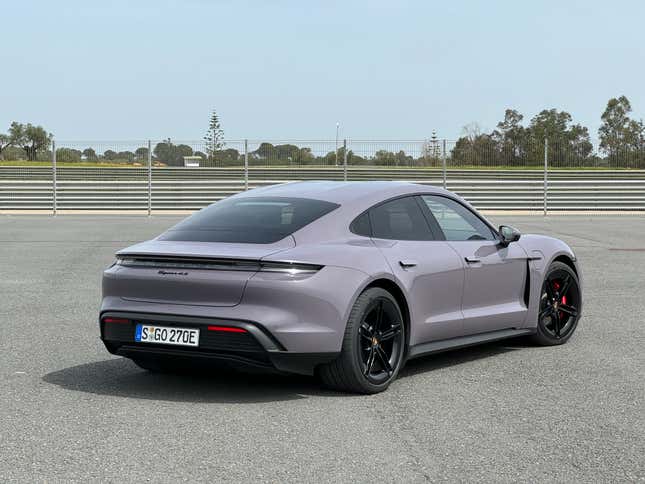
Despite the larger batteries to fill, the new Taycan charges faster, too. Its peak power of 320 kW is 50 kW greater than before, and it holds the peak charge for a lot longer. Thanks to a new heat pump, a more powerful climate system and other tweaks, fast-charging performance is improved in colder weather, with the 2025 model requiring less pre-heating and having a wider temperature range. It now takes the Taycan 18 minutes to charge from 10 to 80 percent on an 800-volt DC fast charger, three and a half minutes quicker than before, and charging speeds are better optimized for 400-volt systems thanks to a new 150-kW DC/DC converter. Porsche says a base RWD Taycan can gain 196 miles of range back in just 10 minutes, almost 60 miles more than before.
I’ve heard mixed reactions from friends and followers about the Taycan’s styling updates; a lot of people seem to miss the old model’s teardrop eyeliner look, but I’m personally into the new updates. The base cars have a more horizontal front bumper design with small vertical intakes that make it look like a smiling tree frog, while Turbos have angular fang-like inserts. There are some cool new aero-focused wheel designs, a bunch of great new colors including Provence, and some fresh options that include an illuminated Porsche script in the taillight bar, a must-have. In photos I was wary of Porsche’s Turbonite finish that’ll be used on the badges, exterior trim and interior accents of all new Turbo models, but in person it has a lot of shimmer and a bronze tinge to the finish that looks really nice.

The view out the front is excellent, though the Taycan’s low roofline, small windows and thick rear pillars impede rear visibility. It’s easy for me to adjust into a good driving position, and at 5’9” I have plenty of space in both the front and rear seats, but the back seats are definitely tighter for taller folks. The Taycans don’t have the biggest cargo areas or frunks, either, but the Cross Turismo’s wagon body makes a big difference. You can now get Race-Tex vegan upholstery with Pepita houndstooth fabric seat centers, which is awesome.
The new Taycan is one of the first cars to support Apple’s expanded CarPlay system, though I’m not able to try it out on the drive; the infotainment as a whole gets Porsche’s latest software, which has a cleaner layout and better functionality. Some of the column stalk controls have been simplified and the curved gauge cluster has redesigned graphics, and if you opt for the passenger display your friend or partner can stream media like Disney Plus while the car is in motion. I’m still not a fan of the Taycan’s air vents, which must be adjusted through one of the central touchscreens.
On the way back to the hotel I pair up with our friend Jason Fenske of Engineering Explained. He took a short direct route out to the track in the morning, so he wants to take the fun long way back and do it in a Turbo S wagon, which he hasn’t experienced yet. (Sadly the Provence one is gone, so we hop in a Chalk car.) Doing the route again, this time in reverse and with the added confidence of knowing both the road and the car better, I push harder and the car takes it in stride.

You’d think I wouldn’t have to keep saying this at this point, but anyone who thinks an electric car can’t be fun needs to drive a Taycan. It’s not just because of the instant torque, which really doesn’t get old and makes mountain driving a pun-intended blast. The Taycan is genuinely just fantastic to drive, calming and luxurious in the city yet engaging and rewarding on a good road. It’ll make you smile and giggle as much as any other Porsche, and isn’t that the goal?
As you may have guessed from all of the updates, the 2025 Taycan is more expensive than before, with increases ranging from $7,345 to $14,545 depending on the model. The rear-drive base car now costs $101,395 including destination, while a top-dog Turbo S Cross Turismo starts at $213,695. That Provence one I drove? It’s $258,085 all-in, and not even fully loaded.
If you can afford the ask, the 2025 Taycan is well worth the money. Its increased range and charging speeds make it easier to justify, and the increased speed and new features make it easier to lust after. The new Taycan is poised to stay fresh and relevant for at least the next few years, even as Porsche starts rolling out next-gen EV models like the Macan and 718. And if a brand new one is out of your reach, Porsche has already sold more than 150,000 Taycans since 2019, many of which have seen huge depreciation. They might not have the increased performance of the brand new Taycan, but all of the inherent excellence is still there.
